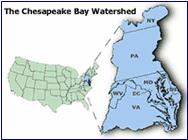|
PHOSPHATES AND NITRATES High amounts of nitrates are found in the Chesapeake Bay. Phosphates (inorganic), phosphorous (organic), and nitrates are used for agricultural purposes in surrounding areas of the Bay. These nutrients are supplemental chemicals that are applied to crops to stimulate growth. Excess nutrients are carried via streams and the water table into the bay. Unnaturally high levels of these nitrates are harmful to the bay because they create a bloom by speeding up the growth of phytoplankton. A bloom will limit the amount of sunlight and therefore result in a limitation of photosynthesis. This reduction will drastically alter all of the plants and animals that live in the ecosystem. Even though it is clear that there is a problem with high nutrient levels in the bay, there are many political issues that limit the improvement in the bay’s water quality. Unless there is an devastating event that opens a political window of opportunity, it is unlikely that the necessary actions which could improve and maintain the water quality in the Chesapeake Bay will be met. The watershed for the Chesapeake Bay Covers a large portion of the east coast. (See map below.) This means that a large portion of the pollutants from Virginia, West Virginia, Delaware, Maryland, Pennsylvania, and southern New York travel through the stream and underground water systems and are all dumped into the Chesapeake Bay. Another variable that affects the level of nitrate and phosphate levels is the time of year. The amount of runoff depends on how much rain has fallen on the nearby streams. The more water that falls in an area, the more nutrients will be washed into the nearby estuaries. In the spring and fall the rains are more plentiful and therefore we should expect to see nutrient levels that are higher than the average annual nutrient levels. It is more common to see nutrient levels for the Chesapeake Bay to be slightly higher than the bay’s annual average because the data from sites one, two, and three came from October when precipitation was higher. For the photosynthesis cycle to be complete we need to have forty-one carbon molecules, seven nitrate, and one phosphate. Nitrate is the number one limiting factor that prevents the completion of this cycle. Phosphate is the second limiting factor. Because we have an abundance of nitrate at site two and an abundance of phosphate at site three, and the water from site two and three are likely to mix at some location in the estuary, it is probable that there will be enough carbon, nitrate and phosphate for this cycle to be complete.
Related sites: http://www.chesapeakebay.net/stressor1.htm http://www.mdcoastalbays.org/ http://www.deq.state.va.us/water/ |

|
PHOTIC ZONE |
|
The amount of phosphates and nitrates in the water strongly affects the photic zone depth. The photic zone depth is the distance from the surface in which light is able to reach. High levels of phosphates and nitrates can cause a bloom, or high concentration of phytoplankton in an area caused by an increase in reproduction. Where there is a bloom, the water is less visible because the water would be overpopulated with phytoplankton. At sites the one and two, the photic zone was at a depth of three-fourths of a meter below the surface, while at site two it was at a depth of two-thirds of a meter. All of these values are relatively close to each other which indicates that the water within the estuary has been well mixed. This mixing could have been caused by the tropical storm in the area. Because the photic zone is shallow, there most likely was a bloom that has taken place within the estuary. The photic zone is periodic in that it varies with the time of day. At night the photic zone is much higher than in would be during the day. In a coastal setting, the photic zone depth also depends on the latitudinal location. In the high latitudes there is greater productivity because there is an excess amount of light and nutrients in the late summer and early fall. Whereas, annually, in the low latitudes, there is a constant amount of light and a constant but low amount of nutrients so there is low productivity all year long. |